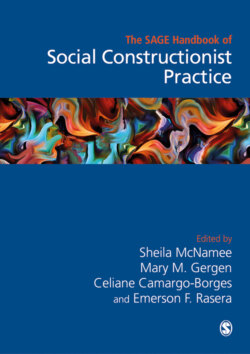Читать книгу The Sage Handbook of Social Constructionist Practice - Группа авторов - Страница 128
На сайте Литреса книга снята с продажи.
Examples of Transmaterial Worlding as Inquiry
ОглавлениеWhat then can research look like in a material world in which the matter of materiality of people's lives and the environments in which we/they live can be storied or researched but not always heard and acted on? Here are a few examples of transmaterial worlding which use a range of systemic questions to bring forth both human and beyond human knowledges, to explore narratives and act as transformational practice by inviting new and empathic ways of knowing.
Research driven by concern for young people at risk in their neighbourhoods could extend the framework of contextual safeguarding (Firmin and Hancock, 2018) to include human and non-human voices and understand research as transformative of people, places, discourses and power structures:
If the voices of stairwells in housing estates were included as research participants, what would they say works well about them as spaces to allow effective intimidation of young people by people who lead them into trouble?
How can research support young people to re-design the stairwells in their block of flats and empower them to make their views heard by those in power to make changes?
How can research map where local people, landlords and local organisations say the threshold is between personal monetary gain and social gain? And how can research bring forth their ideas for what can be done where doing nothing is not an option?
Research into the impact of mountain climbing on Everest could ask climbers, guides and travel agents questions designed to disrupt common tourism practice by enhancing transmaterial empathy and imagining more eco-sensitive positioning:
How could the snow at the bottom of Everest make its experience of being transformed by climbers heard in ways that climbers changed their practices?
How might human and non-human stakeholders in Everest map the tipping point between profit or gain of the individual, and the well-being of the mountain and its indigenous communities?
What kind of pre-booking preparation could there be for climbers to empathise with the mountain and its surrounding ecology before making a decision to book their trip?
If climbing Everest was no longer an option for more than a few people each month, what would others do who did not win a ticket in this lottery?
An inquiry into how current residents are affected by illness and lost relatives through radioactive toxicity brought into their worlds by local factories or nuclear plants (see the moving ethnographic research by Cathy Richardson/Kinewesquao (2018)) could ask:
Do the spirits of your ancestors speak to you about their experience or yours? How do they communicate? What do they advise you to do?
What are the languages that you feel local government officials are most likely to listen to when local people express worry about their sickness?
How can research support local people to teach government officials local knowledge and practices of knowing?
If local government officials understood your experiences and could listen to what the land has to say and took advice from your ancestors, what would persuade them to act on this understanding and knowledge? What would they see that convinced them that this had been a good thing to do?
How have you managed to keep alive practices that give life and hope?
These systemic questions invite relational reflexivity from the people being asked the question. The questions are based on an idea that questions are never neutral and are a contextual intervention for the person being asked a question (Selvini Palazzoli et al., 1980; Tomm, 1988). Some questions invite an ‘ethic of care’ in ‘imagining the other’ (McCarthy and Byrne, 2007). Others are hypothetical questions (Tomm, 1988), context-setting questions, appreciative inquiry, hope-oriented, narrative questions. Systemic therapy has a rich array of types of questions, a theory of transformation through dialogue and relational response-ability theories (for example, Burnham, 1992; Fredman, 2004; Hedges, 2005; McCarthy and Byrne, 2007; Tomm, 1988; Waldegrave et al., 2003).
